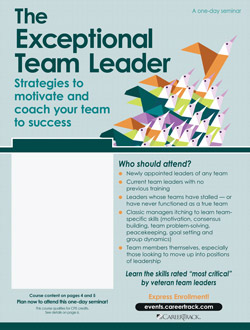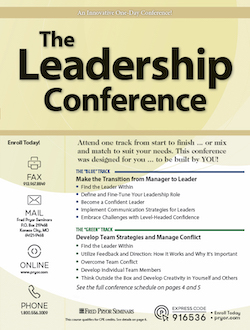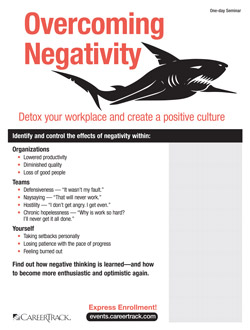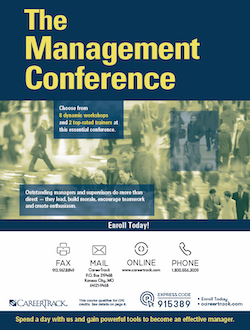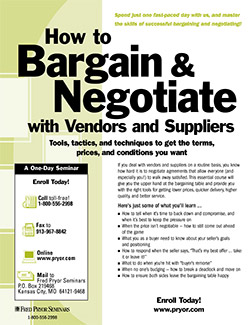Best Practices for Employee Recognition
- Author: Pryor Learning
- Categories:
- Tags:
- Share on:
While you can’t praise too often, you can praise badly. This is the premise of a recent white paper titled, “The Manager’s Field Guide to Recognition”[1].
For some managers, employee recognition comes naturally. For others – perhaps even most – creating a system for effective feedback can seem time-consuming and uncomfortable. Understanding best practices of a successful employee recognition program removes some of this anxiety.
Here are five ways to practice “great recognition” as described in “The Manager’s Field Guide to Recognition.”
1. Be specific – To create the most impact, tie praise to a clear action. “Thanks for being a great employee” doesn’t convey any meaningful information to the employee about what they did and runs a high risk of sounding insincere. Instead include specific information, such as “Your presentation today really communicated the steps we need to take”. This demonstrates that you were paying attention, and reinforces an action that you want them to repeat.
2. Be spontaneous – Don’t wait until an annual review to offer positive feedback or you will miss hundreds of opportunities to demonstrate appreciation and reinforce desired behaviors. Management expert Ken Blanchard put it this way: “Help people reach their full potential. Catch them doing something right”[2]. Employees will give up on going the extra mile if their effort isn’t recognized before their next opportunity
to do so.
3. Be fair – Make every effort to be consistent and transparent in your praise. Nothing destroys morale more than a perception of favoritism or recognition based on something other than objective factors. While it sounds obvious, this may be one of the hardest goals for a manager to achieve. Many human biases are so subconscious that it takes supreme conscious effort to avoid them.
Take for example a recent study published by the National Bureau of Economic Research. This study shows teachers graded math papers lower when they knew the student was a girl than when the same papers were graded anonymously[3], despite the teachers themselves all being women. Being fair may take deliberation and regular self-evaluation, especially if you work in a diverse work environment.
4. Personalize – Even though personality typing, embraced by many hiring managers, many businesses forget to personalize recognition and rewards. A big, loud “atta-boy” in a public meeting may be perfect for an extroverted employee but terrify an introverted one to the point of avoiding exemplary work. A reward that emphasizes individual initiative may unfairly penalize the person who works well collaboratively.
Personalizing the way that you praise your employees satisfies each individual’s need for recognition, and conveys your effort of paying attention to their preferences.
5. Be strategic – Once you are comfortable identifying and executing positive feedback, take it to the next level:
- Employ strategic praise during periods of change management to ease tensions and accelerate transitions.
- Target specific skills or behaviors that directly impact revenue, productivity or even corporate culture. “Catch them doing good” when those skills are demonstrated.
- Match praise and awards to match effort. A quick note of appreciation in an email for months of above-and-beyond work on a project will backfire if the response is perceived as weak in relation to the effort.
Finally, the most important skill in creating great recognition is to simply be genuine. You may find that the habit of looking for the positive actually improves your own job satisfaction.
[1]http://go.globoforce.com/rs/globoforce/images/ManagersFieldGuideWEB.pdf”>http://go.globoforce.com/rs/globoforce/images/ManagersFieldGuideWEB.pdf
[2]One Minute Manager by Kenneth Blanchard, PH.D. & Spencer Johnson, M.D.
[3]http://www.slate.com/blogs/xx_factor/2015/02/10/teacher_bias_in_math_new_study_finds_teachers_grade_boys_more_generously.html
Choose a Seminar and Save $10
Styles & Strategies to Supervise Effectively
1 Day
- CEU: 0.6
- CPE: 6
Team Training - Virtual or In-person

Spark Innovation and Think Strategically
1 Day
- CEU: 0.6
- CPE: 6
Team Training - Virtual or In-person

How to Manage Remote Employees
1 Day
- CEU: 0.6
- CPE: 6
- HRCI: 5.5
- PDC: 6
Team Training - Virtual or In-person
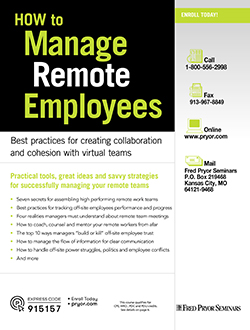
How to Supervise People
1 Day
- CEU: 0.6
- CPE: 6
- PDC: 6
Virtual Seminars:
-
Apr 16
-
Apr 17
-
Apr 22
-
+ 26 more dates
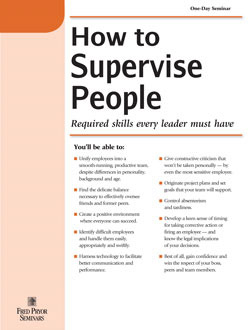
Facilities Management - A 2-Day Comprehensive Course
2 Days
- CEU: 1.2
- CPE: 12
Virtual Seminars:
-
Apr 16-17
-
Apr 23-24
-
Apr 29-30
-
+ 25 more dates
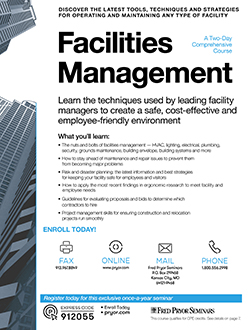
Managing with Assertive Confidence
1 Day
- CEU: 0.6
- CPE: 6
Virtual Seminars:
-
Apr 16
-
Apr 22
-
May 8
-
+ 3 more dates

Leadership, Team-Building and Coaching Skills for Managers and Supervisors
1 Day
- CEU: 0.6
- CPE: 6
- HRCI: 5.5
- PDC: 6
- PDU: 6
Virtual Seminars:
-
Apr 16
-
Apr 17
-
Apr 18
-
+ 41 more dates
In-Person Events:
- Apr 16, San Diego, CA
- Apr 22, Indianapolis, IN
-
+ 20 more dates

Transitioning to Supervisor
1 Day
- CEU: 0.6
- CPE: 6
Virtual Seminars:
-
Apr 17
-
Apr 18
-
Apr 22
-
+ 41 more dates
In-Person Events:
- Apr 22, Phoenix, AZ
- Apr 23, Ontario, CA
-
+ 14 more dates
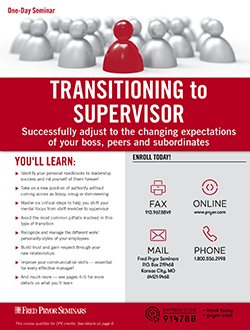
Leadership & Management Skills for Women
1 Day
- CEU: 0.6
- CPE: 6
Virtual Seminars:
-
Apr 17
-
Apr 29
-
May 7
-
+ 8 more dates
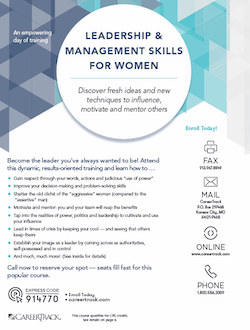
How to Supervise Bad Attitudes and Negative Behaviors
1 Day
- CEU: 0.6
- CPE: 6
- HRCI: 5.5
- PDC: 6
Virtual Seminars:
-
Apr 17
-
Apr 22
-
Apr 25
-
+ 18 more dates

Management & Leadership Skills for New Managers and Supervisors (2-Day)
2 Days
- CEU: 1.2
- CPE: 12
Virtual Seminars:
-
Apr 17-18
-
Apr 22-23
-
Apr 24-25
-
+ 32 more dates
In-Person Events:
- Apr 16-17, Atlanta, GA
- Apr 29-30, Denver, CO
-
+ 21 more dates

How Managers Become Great Leaders
1 Day
- CEU: 0.6
- CPE: 6
Virtual Seminars:
-
Apr 17
-
Apr 18
-
Apr 23
-
+ 16 more dates
In-Person Events:
- Jul 22, Nashville, TN
- Jul 25, Las Vegas, NV

A Crash Course for the First-Time Manager or Supervisor
1 Day
- CEU: 0.6
- CPE: 6
- HRCI: 5.5
- PDC: 6
Virtual Seminars:
-
Apr 18
-
Apr 22
-
Apr 24
-
+ 27 more dates
In-Person Events:
- Jun 13, Phoenix, AZ
- Jun 18, New York, NY
-
+ 2 more dates

Criticism & Discipline Skills for Managers and Supervisors
1 Day
- CEU: 0.6
- CPE: 6
- HRCI: 5.5
- PDU: 6
Virtual Seminars:
-
Apr 23
-
May 6
-
May 15
-
+ 13 more dates

The Indispensable Office Manager
1 Day
- CEU: 0.6
- CPE: 6
Virtual Seminars:
-
Apr 23
-
May 1
-
May 6
-
+ 5 more dates
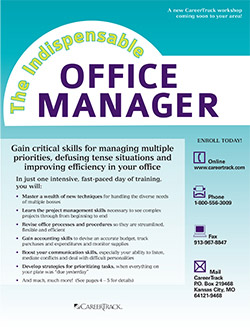
Be the Manager Your Employees Want to Follow
1 Day
- CEU: 0.6
- CPE: 6
- PDC: 6
Virtual Seminars:
-
May 5
-
May 8
-
May 14
-
+ 5 more dates
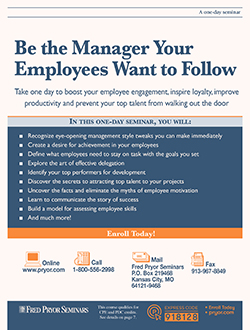
How to Improve Employee Accountability with Remote and In-Person Teams
1 Day
- CEU: 0.6
- CPE: 6
- PDU: 6
Virtual Seminars:
-
Jun 3
-
Jun 9
-
Jun 18
-
+ 5 more dates

The Exceptional Team Leader
1 Day
- CEU: 0.6
Virtual Seminars:
-
Jun 3
-
Jun 9
-
Jun 18
-
+ 5 more dates
